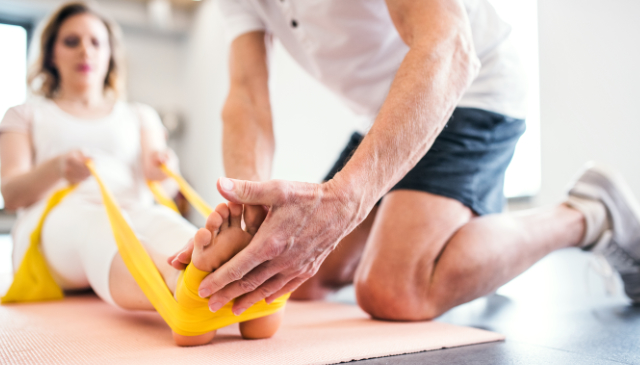Health Blog
March 20, 2025

Achilles tendinopathy is a common overuse injury that affects the tendon connecting your calf muscles to your heel bone. It often develops in runners and active individuals due to repetitive stress and inadequate recovery. Those with Achilles tendinopathy may experience pain, stiffness, and difficulty performing high–impact activities like running or jumping. The good news? With proper treatment and a gradual return–to–sport plan, a complete recovery can be achieved.
The path back to sports after Achilles tendinopathy requires careful management to prevent further injury. A recent study shed some light on how running patterns and loading symmetry–the balance between the affected and unaffected leg–impact pain when a patient is preparing to return to sports. While these findings provide valuable insights, they also highlight the importance of consulting a physical therapist to tailor your recovery plan and ensure a safe return to your favorite athletic pursuit.
The Study: Running Patterns and Pain During the Return–to–Sport Phase
Researchers investigated the relationship between pain in the Achilles tendon and running symmetry in patients with Achilles tendinopathy during the return–to–sport phase, which is the period of recovery when a patient prepares to get back into their preferred sport or activity. Here are the key findings:
- Loading Asymmetry and Pain: Runners who favored their uninjured leg experienced increased pain in their injured Achilles tendon, especially on consecutive running days.
- Consecutive Run Days: Pain worsened with more consecutive days of running without adequate rest, underscoring the need for recovery days in a return–to–sport program.
- Running Frequency: Interestingly, the total number of running sessions over two weeks did not significantly impact the severity of symptoms in the short term, so long as their overall distance was controlled.
These results emphasize the importance of balancing one's load during running and highlight how using improper mechanics can prolong pain and recovery time.
Why Physical Therapy Is Essential
Navigating the return to sports after Achilles tendinopathy can be challenging but seeing a physical therapist can make a major difference. Here's how a physical therapist can support your recovery:
1. Personalized Rehabilitation Plans
Physical therapists develop customized programs that consider your unique needs, pain levels, and activity goals. They use evidence–based approaches to help you progress safely through the return–to–sport phase.
2. Gait Analysis and Correction
Some physical therapists will use tools like wearable sensors or video analysis to identify and address running patterns that are asymmetrical. Correcting these mechanics reduces stress on the injured tendon and minimizes the risk of reinjury.
3. Gradual Load Progression
Progressive loading is key to Achilles tendinopathy recovery. A therapist will guide you through exercises that gradually strengthen the tendon, ensuring it can handle increasing demands over time.
4. Pain Monitoring and Recovery Guidance
Therapists can teach you how to monitor pain levels during activity and recognize when to rest. They'll also recommend the optimal frequency and duration of runs to support tendon healing.
Tips for a Successful Return to Sports
If you're currently recovering from Achilles tendinopathy, here are some additional tips to make your transition back to sports smoother:
- Prioritize Recovery Days: Avoid running on consecutive days to give your tendon time to heal and remodel.
- Monitor Pain Levels: Use a pain scale to gauge your symptoms. Mild discomfort (2–3 out of 10) during activity is generally acceptable, but pain should subside quickly after.
- Focus on Strengthening: Incorporate exercises like heel raises, eccentric calf exercises, and resistance training to build tendon strength.
- Seek Professional Guidance: A physical therapist can provide expert advice and adjust your program based on your progress.
What This Means for You
Returning to your prior level of performance after Achilles tendinopathy is possible with the right approach, and this study reinforces the importance of balanced running mechanics and adequate recovery to minimize pain and improve outcomes. However, every recovery journey is unique, which is why working with a physical therapist is so valuable. They'll ensure your rehabilitation program is tailored to your needs, helping you achieve a full and safe return to your favorite activities.
Contact Us Today For More Information
If you're recovering from Achilles tendinopathy or have questions about returning to sports, our experienced physical therapists are here to help. Call our clinic today to learn more or to schedule an appointment.
For more information about the featured study, click here.
